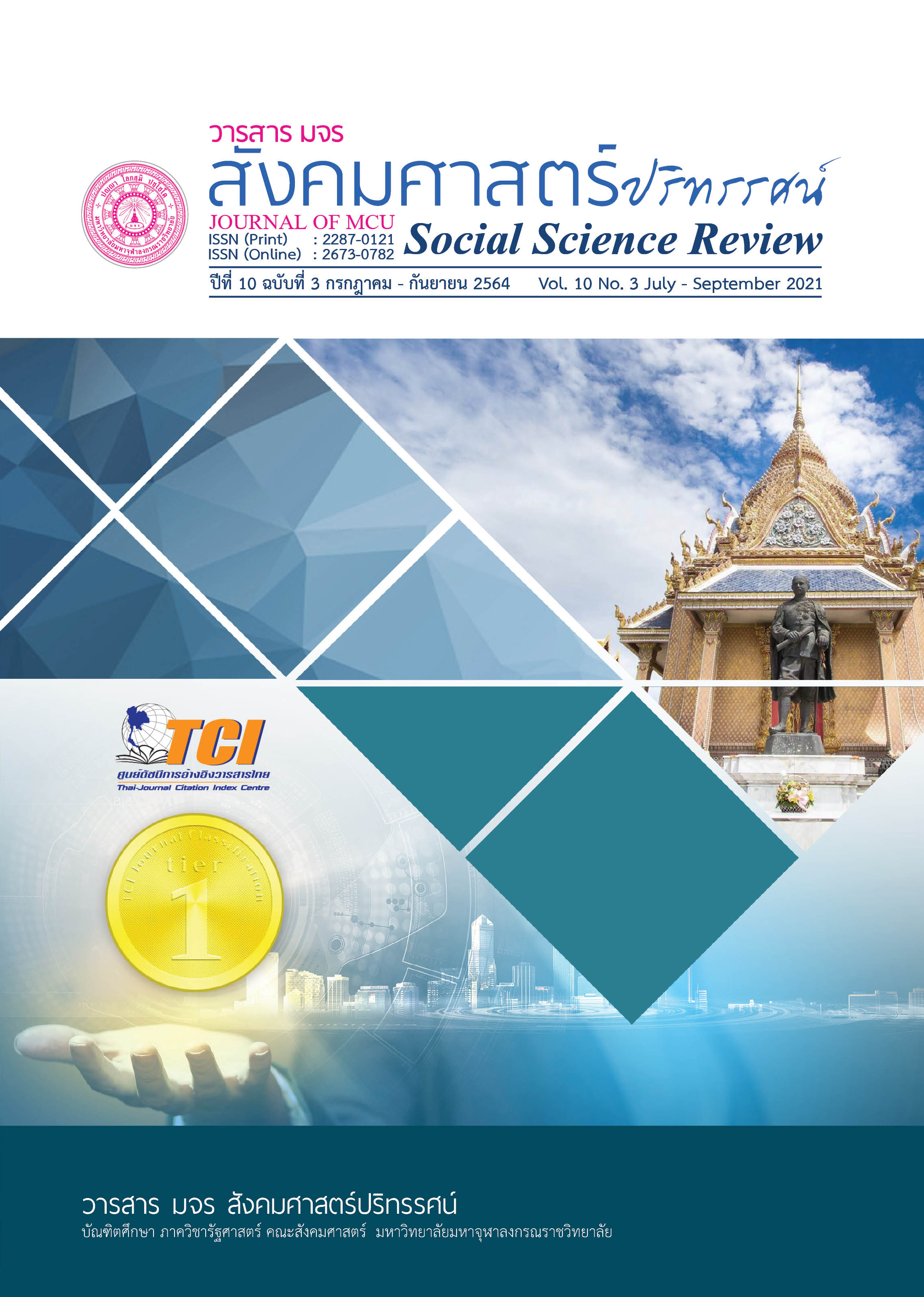การพัฒนารูปแบบการเรียนการสอนระบบ e-Learning สาขาวิชาปรัชญาศาสนาและวัฒนธรรม มหาวิทยาลัยมหามกุฏราชวิทยาลัย วิทยาเขตมหาวชิราลงกรณราชวิทยาลัย
คำสำคัญ:
การพัฒนา, การเรียนการสอน, ระบบ e-Learningบทคัดย่อ
บทความวิจัยนี้มีวัตถุประสงค์เพื่อ 1. จัดทำบทเรียนอิเล็กทรอนิกส์ (e-Learning) รายวิชาในสาขาวิชาปรัชญา ศาสนาและวัฒนธรรม 2. เปรียบเทียบผลสัมฤทธิ์ทางการเรียนก่อนเรียนและหลังเรียนและ 3. เปรียบเทียบเจตคติทางการเรียนของนักศึกษากลุ่มตัวอย่างที่ใช้ในการวิจัยครั้งนี้ เป็นนักศึกษา จำนวน 15 รูป/คน ซึ่งได้มาจากการเลือกแบบเจาะจง (Purposive Sampling) เครื่องมือที่ใช้ในการวิจัย ได้แก่ แบบทดสอบวัดผลสัมฤทธิ์ทางการเรียน สถิติที่ใช้ในการวิเคราะห์ข้อมูล ได้แก่ ค่าเฉลี่ย (Mean) ส่วนเบี่ยงเบนมาตรฐาน(Standard Deviation) และการทดสอบสมมุติฐานด้วย Paired t–test
ผลการวิจัยพบว่า 1. กลุ่มตัวอย่างที่เรียนบทเรียนอิเล็กทรอนิกส์ (e-Learning) รายวิชาในสาขาวิชาปรัชญา ศาสนาและวัฒนธรรมมี คะแนนเฉลี่ยผลสัมฤทธิ์ทางการเรียนหลังเรียนสูงกว่าก่อนเรียน แตกต่างกันอย่างมีนัยสำคัญที่ระดับ.01 2. กลุ่มตัวอย่างที่เรียนบทเรียนอิเล็กทรอนิกส์ (e-Learning) รายวิชาในสาขาวิชาปรัชญา ศาสนาและวัฒนธรรมมีเจตคติทางการเรียน รายข้อ และโดยรวม หลังเรียนสูงกว่าก่อนเรียน แตกต่างกันอย่างมีนัยสำคัญที่ระดับ.01 โดยสรุป การพัฒนารูปแบบการเรียนการสอนระบบ e-Learning ในการจัดกิจกรรมการเรียนการสอน สามารถทำให้นักศึกษามีผลสัมฤทธิ์ทางการเรียนสูงขึ้น และมีเจตคติที่ดีต่อการเรียนการสอนระบบ e-Learning จึงควรส่งเสริมสนับสนุนให้อาจารย์นำไปใช้ในการจัดการเรียนการสอน เพื่อให้ผู้เรียนบรรลุผลตามจุดประสงค์ของรายวิชาต่อไป
เอกสารอ้างอิง
กิตติพงษ์ พุ่มพวงและคณะ. (2563). การพัฒนารูปแบบการเรียนการสอนอีเลิร์นนิงด้วยการเรียนรู้ร่วมกันผ่านสังคมออนไลน์เพื่อพัฒนาทักษะการรู้สารสนเทศ สำหรับผู้เรียนระดับปริญญาตรีคณะครุศาสตร์/ศึกษาศาสตร์. วารสารศึกษาศาสตร์ มหาวิทยาลัยนเรศวร, 22(1), 29-44.
ถนอมพร เลาหจรัสแสง. (2551). ความหมายของ E-Learning. สืบค้น 20 กุมภาพันธ์ 2562, จาก https://www.kroobannok.com/1586
ทัศน์มน หนูนิมิต. (2551). การเปรียบเทียบผลสัมฤทธิ์ทางการเรียนการคิดวิเคราะห์และทักษะกระบวนการวิทยาศาสตร์ขั้นพื้นฐานของนักเรียนชั้นประถมศึกษาปีที่4ที่ได้รับการจัดการเรียนรู้โดยใช้ปัญหาเป็นหลักประกอบแผนผังความคิดและสืบเสาะหาความรู้ 7 ขั้นตอน (วิทยานิพนธ์การศึกษามหาบัณฑิตสาขาวิชาหลักสูตรและการสอน). มหาสารคาม: มหาวิทยาลัยมหาสารคาม.
ปราวีณยา สุวรรณณัฐโชติ. (2555). E-Learning. สืบค้น 16 มกราคม 2564, จาก http://elg2320.blogspot.com/
ปรียาพร วงศ์อนุตรโรจน์. (2546). จิตวิทยาการศึกษา. กรุงเทพฯ: พิมพ์ดี.
พงศ์กรดอทเน็ต. (2559). E-Learningนวัตกรรมเพื่อคุณภาพการศึกษาในสังคมแห่งการเรียนรู้. สืบค้น 16 มกราคม 2564, จาก https://bit.ly/2ntf7Hu
พระนิวัฒน์ สนฺตจิตฺโต. (2561). การพัฒนาเทคนิคการสอนของพระสอนศีลธรรมในโรงเรียนอำเภอคลองหลวง จังหวัดปทุมธานี, วารสารสหวิทยาการนวัตกรรมปริทรรศน์, 1(1) , 13-25.
พระมหาวริทริ์ชาการ วชิรสิทธิเมธี. (2563). ประสิทธิผลการบริหารจัดการโรงเรียนพระปริยัติธรรมแผนกสามัญศึกษา จังหวัดพระนครศรีอยุธยา. วารสารพุทธนวัตกรรมและการจัดการ, 3(1) , 11-19.
พระยงยุทธ กตธุโร. (2564). การพัฒนาการเรียนการสอนวิชาพระพุทธศาสนาของพระสอนศีลธรรมในโรงเรียนในอำเภอหัวหิน จังหวัดประจวบคีรีขันธ์. วารสารพุทธนวัตกรรมและการจัดการ, 4(1) , 28-36.
พระวีรสิษฐ กมฺมสุทฺโธและคณะ. (2562). การใช้เทคโนโลยีสารสนเทศของพระสงฆ์เพื่อการสอนศีลธรรมในโรงเรียนมัธยมศึกษาตอนปลาย อำเภอโพธาราม จังหวัดราชบุรี. วารสารสหวิทยาการนวัตกรรมปริทรรศน์, 2(2) , 11-23.
ล้วน สายยศ และอังคณา สายยศ. (2539). เทคนิคการวัดผลการเรียนรู้. กรุงเทพฯ: ชมรมเด็ก.
เศรษฐพงค์ มะลิสุวรรณ. (2561). บทบาทการศึกษาไทยในยุคไทยแลนด์ 4.0. สืบค้น 4 มกราคม 2564, จาก https://bit.ly/2yBcFBi
สมนึก ภัททิยธนี. (2546). การวัดผลการศึกษาพิมพ์ครั้งที่ 4. กาฬสินธุ์: ประสานการพิมพ์.
สิริกุล อินพานิช. (2550). การเปรียบเทียบผลสัมฤทธิ์ทางการเรียนความสามารถในการคิดวิเคราะห์และเจตคติต่อวิชาคณิตศาสตร์ของนักเรียนชั้นมัธยมศึกษาปีที่ 5 ที่เรียนโดยกิจกรรมการเรียนรู้แบบสืบเสาะหาความรู้และกิจกรรมการเรียนรู้ตามปกติ เรื่องความน่าจะเป็น (วิทยานิพนธ์การศึกษามหาบัณฑิต สาขาวิชาหลักสูตรและการสอน). มหาสารคาม: มหาวิทยาลัยมหาสารคาม.
สุชาดา สามสวัสดิ์. (2555). E-Learning กับการศึกษาไทย (E-Learning with Thai Education). สืบค้น 24 เมษายน 2564, จาก http://www.ranod.ac.th/image/por.pdf
สุธีธิดา บรรณารักษ์. (2555). การเปรียบเทียบผลสัมฤทธิ์ทางการเรียนการคิดสังเคราะห์และเจตคติต่อวิชาภาษาไทยเรื่องอลังการภาพพจน์บทพากย์เอราวัณของนักเรียนชั้นมัธยมศึกษาปีที่ 3 ที่จัดการเรียนรู้แบบ CIPPA กับการจัดการเรียนรู้แบบ KWL PLUS (วิทยานิพนธ์การศึกษามหาบัณฑิตสาขาวิชาหลักสูตรและการสอน). มหาสารคาม:มหาวิทยาลัยมหาสารคาม.
อัจฉรา อ่อนเจริญ. (2558). ประโยชน์ของ "E-Learning" และข้อดีและข้อจำกัดของ "E-Learning". สืบค้น 17 กรกฎาคม 2562, จาก https://bit.ly/2MAmUhq
Casey, A. (2016). 7 Characteristics of learner-centered e-Learning. Retrieved March 20, 2020, from https://bit.ly/2M0U6ir
Mahamakut buddhist university maha vajiralongkorn university. (2021). MBUMRC e-Learning. Retrieved March 20, 2021, from https://mrc.mbu.ac.th/e-learning/?lang=en
ดาวน์โหลด
เผยแพร่แล้ว
รูปแบบการอ้างอิง
ฉบับ
ประเภทบทความ
สัญญาอนุญาต
ลิขสิทธิ์ (c) 2021 วารสาร มจร สังคมศาสตร์ปริทรรศน์

อนุญาตภายใต้เงื่อนไข Creative Commons Attribution-NonCommercial-NoDerivatives 4.0 International License.
เพื่อให้เป็นไปตามกฎหมายลิขสิทธิ์ ผู้นิพนธ์ทุกท่านต้องลงลายมือชื่อในแบบฟอร์มใบมอบลิขสิทธิ์บทความให้แก่วารสารฯ พร้อมกับบทความต้นฉบับที่ได้แก้ไขครั้งสุดท้าย นอกจากนี้ ผู้นิพนธ์ทุกท่านต้องยืนยันว่าบทความต้นฉบับที่ส่งมาตีพิมพ์นั้น ได้ส่งมาตีพิมพ์เฉพาะในวารสาร มจร สังคมศาสตร์ปริทรรศน์ เพียงแห่งเดียวเท่านั้น หากมีการใช้ภาพหรือตารางหรือเนื้อหาอื่นๆ ของผู้นิพนธ์อื่นที่ปรากฏในสิ่งตีพิมพ์อื่นมาแล้ว ผู้นิพนธ์ต้องขออนุญาตเจ้าของลิขสิทธิ์ก่อน พร้อมทั้งแสดงหนังสือที่ได้รับการยินยอมต่อบรรณาธิการ ก่อนที่บทความจะได้รับการตีพิมพ์ หากไม่เป็นไปตามข้อกำหนดเบื้องต้น ทางวารสารจะถอดบทความของท่านออกโดยไม่มีข้อยกเว้นใดๆ ทั้งสิ้น





